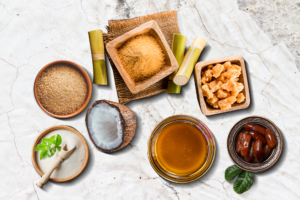The evolution of taste enhancement in the food industry is being dramatically reshaped by technology-driven taste modulators, exemplified by our proprietary TasteProTM platform. We’re moving beyond simple additives, using processes like the Maillard reaction in our Reaction Flavours to craft complex, authentic profiles. Our innovations, such as TastePro™ Sodium Reduction Tool and TastePro™Sweet Modulator, directly address consumer demands for healthier options, enabling significant reductions in sodium and sugar without sacrificing taste. Furthermore, our NutriGrain represents a new era of functional ingredients, offering enhanced nutrition.
Technology-driven taste modulators are revolutionising food formulation by offering precise control over taste and functionality. Our Cocoa Replacer, Savoury Enhancer, Savoury Booster, and Cool Sensation ingredients demonstrate the breadth of possibilities, from cost-effective flavour alternatives to unique sensory experiences. Beyond flavour, Symgel showcases how technology can enhance texture and coating, vital for packaged goods. This isn’t just about masking or adding flavours; it’s about crafting a holistic sensory experience that aligns with modern consumer preferences for health, authenticity, and innovation.
Now that we have a fair idea of what our taste modulators do, let’s explore the world of taste and flavour modulators.
What Are Taste Modulators?
Taste modulators are the culinary architects of sensory perception. They don’t just add flavour; they orchestrate it. It’s about precision at the molecular level. Unlike traditional flavour additives, which are essentially ‘flavour notes’ themselves, modulators are the conducting baton that brings out the best in existing flavours. They interact with taste receptors on the tongue through sophisticated mechanisms. This could involve blocking bitterness receptors or amplifying sweetness pathways with finesse. This isn’t just flavour enhancement; it’s flavour engineering.
Taste Modulators Market Overview
The taste modulator market isn’t just expanding; it’s booming. It is experiencing an evolutionary shift, led by health-conscious consumers. The demand for ‘better-for-you’ products that don’t sacrifice taste is insatiable. This is not a passing fad; it is a fundamental shift in consumer expectations. Food makers are currently under enormous pressure to deliver goods that are both healthy and delicious. Taste modulators are especially useful in this situation. They are the key that opens the door to developing products that fulfil these changing needs. The market is incredibly dynamic, and innovation occurs at a rapid speed.
Source: Mordor Intelligence
Key Benefits of Taste Modulation
Taste modulation isn’t just about tweaking flavours. It’s a strategic lever for creating products that appeal to today’s health-conscious, experience-driven consumers. Modulators respond to the increased demand for healthier formulations by allowing large reductions in sugar, salt, and fat while maintaining taste. Taste modulators preserve the pleasure of eating without the guilt. Let’s see how that is achieved.
Healthier formulations
We’re enabling food scientists to perform what was once considered culinary alchemy. With flavour modulators what used to be an indulgent and restrictive sugar heavy dessert is now a more accessible treat. The same goes for a low-sodium snack. This is the power of taste modulation. It is not just reducing unhealthy ingredients, it’s making healthy ingredients taste amazing.
Enhanced mouthfeel
Beyond basic tastes, modulators can sculpt the very texture of food. We can create a creamy sensation in a dairy-free product or add a luxurious richness to a low-fat formulation. Not only does this allow manufacturers to expand their product line, when timed right, it can potentially open up a new product segment. This is about elevating the entire sensory experience, not just the flavour profile.
Versatility
The applications are boundless. From beverages to baked goods, savoury snacks to sweet confections, taste modulators offer unparalleled flexibility. We’re talking about fine-tuning flavour profiles with scientific accuracy, allowing for the creation of truly exceptional products.
Crafting Exceptional Sensory Experiences with Symega’s Flavour Modifiers
Our TasteProTM range of flavour modifiers allows manufacturers to revolutionize product development, offering them unparalleled control over sensory profiles. While our Reaction Flavours deliver complex, rich tastes through advanced chemical reactions, our Sweet Modulator enables significant sugar reduction with a natural, clean-label approach. Enzyme-Modified Dairy Flavours (EMDF) provide concentrated, authentic dairy notes, and our Cocoa Replacer offers a sustainable, cost-effective alternative to natural cocoa without sacrificing taste or mouthfeel. These solutions empower brands to create healthier and consistently superior products, meeting the evolving demands of today’s discerning consumers. Let’s have a glance at what Symega has to offer.
Reaction Flavours
Reaction flavours are flavour compounds that emerge organically during the cooking or processing of food ingredients. They lend depth and complexity to taste profiles that cannot be easily replicated with other flavouring agents. Symega’s reaction flavours blend seamlessly with your existing bakery and snacks production process.
Sweet Modulator
Addressing the growing need for low-sugar solutions, our Sweet Modulator provides a groundbreaking solution. With a sweetness potency 300 times that of sugar and a zero-calorie profile, producers can accomplish significant sugar reduction while maintaining the required sweetness intensity. This clean-label ingredient offers a natural method to create healthier, yet delectable dairy, confectionery, bakery products and beverages.
Enzyme Modified Dairy Flavours
Enzyme Modified Dairy Flavours or EMDF, offer a superior solution for dairy-based manufacturers seeking to intensify natural flavours while maintaining consistent quality. These innovative ingredients provide a powerful flavour boost, allowing for cost-effective formulation and enhanced sensory experiences in your bakery, confectionery and dairy products.
Cocoa Replacer
A cocoa substitute that addresses the shortage of high-quality cocoa while offering a sustainable and cost-effective solution. This carefully crafted cocoa replacer replicates the exceptional taste, texture, and appearance of natural cocoa, effectively addressing the supply-demand gap in the food and beverage industry, more specifically in bakery, confectionery and dairy applications without compromising on quality.
Our range of taste modulators doesn’t end here. From our award-winning TastePro™ Sodium Reduction Tool to TastePro™Fat Replacer and more, we offer innovative, technology-driven solutions that enhance flavour and functionality. Connect with our team at info@symega.com to learn how you can partner with us and meet evolving market demands.
Applications of Flavour Modifiers in Food Science
Taste modulators are pivotal in driving innovation across diverse food industries, transforming health-focused products into consumer favourites. Essentially, taste modulators are the essential bridge, making healthy eating both accessible and enjoyable across a wide spectrum of food products.
Functional Foods
Functional foods are the future of preventative health, and taste modulators are making them palatable. Manufacturers can offer their consumers healthier choices because modulators can mask the harsh bitterness of certain vitamins and minerals.
Beverages
The beverage business is experiencing a steady change. The demand for low-sugar and plant-based beverages is certainly increasing. Taste modulators are vital for generating healthy and refreshing products.
Baked Goods
Creating nutritious bakery products is challenging. However, flavour modulators are changing the game. We can enhance sweetness, improve texture, and make goods that are both nutritious and delicious.
Dairy
Dairy alternatives are becoming increasingly popular, and flavour modulators have become crucial for emulating the creamy richness of traditional dairy products.
Snacks
The snack industry is all about flavour, and taste modulators are helping to create healthier snacks that don’t sacrifice taste.
Confectionery
Creating low-sugar candies that can easily be confused for their full-flavour counterparts is a very difficult task, taste modulators are making that possible.
Future of Taste Modulators in Food Innovation
The future of flavour modification is quite interesting. Advances in food technology, along with a better grasp of sensory science, are paving the way for more accurate and effective modulators. AI is being used to map out the finest flavour combinations, while encapsulation technology is being employed to ensure that flavours are released at the appropriate time during food intake. Plant-based foods will rely largely on these modulators. And we may expect to see more natural-derived modulators on the market.
FAQs
Traditional flavour enhancers augment existing taste profiles, increasing their intensity. Taste modulators, on the other hand, actively modify the perception of fundamental tastes like sweetness, bitterness, and saltiness without imparting their own distinct flavour. They modify the sensory experience rather than just amplifying it.
The food industry utilizes a diverse array of taste modulators, each addressing a distinct sensory feature. These include sweetness enhancers to reduce sugar, bitterness blockers for improved palatability, salt enhancers to reduce sodium, umami boosters for savoury applications, sour modulators to modulate acidity, and mouthfeel enhancers to optimise tactile properties.
The development and validation of taste modulators necessitate a stringent scientific approach. This involves advanced sensory science methodologies, instrumental analysis using techniques like electronic tongues, and comprehensive sensory evaluation by expert panels. Rigorous testing protocols ensure the effectiveness and consistency of these ingredients in diverse food matrices.
Indeed. The food industry is increasingly prioritising natural and clean-label solutions. Consequently, research and development efforts are focused on identifying and utilising naturally derived taste-modifying compounds. This trend underscores the feasibility of incorporating taste modulators into products that meet consumer demand for transparency and natural ingredients.




